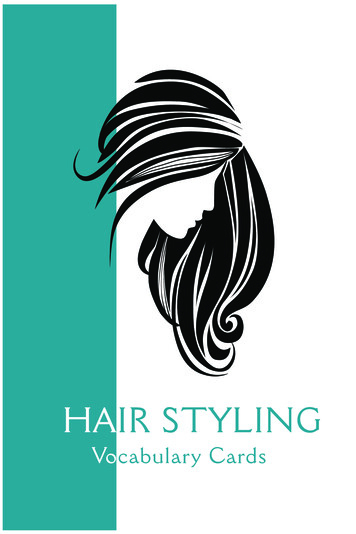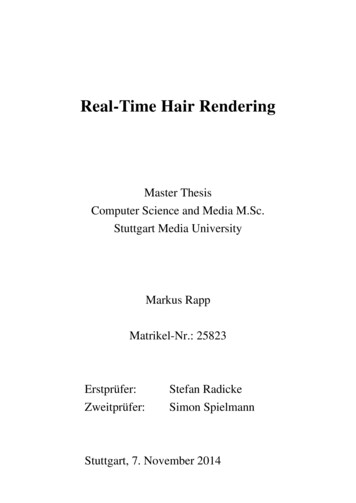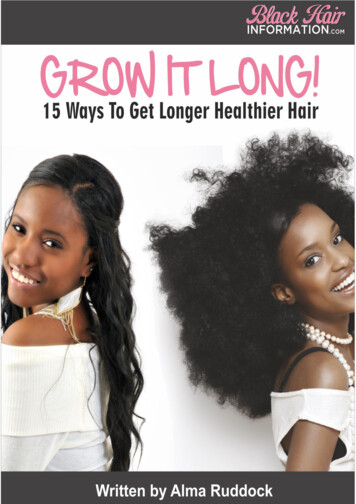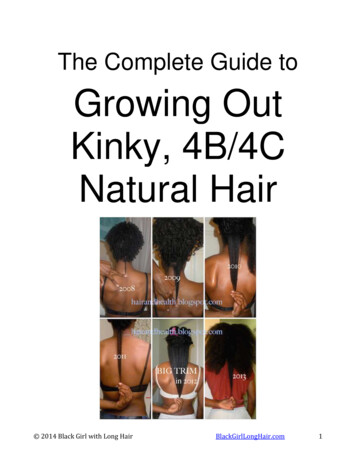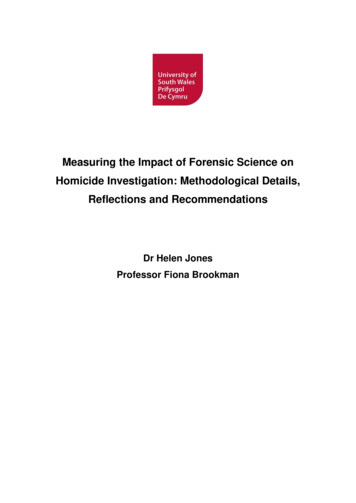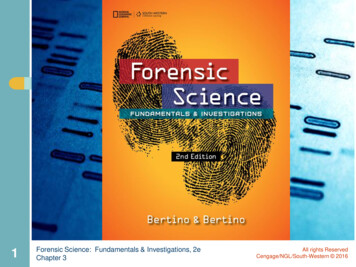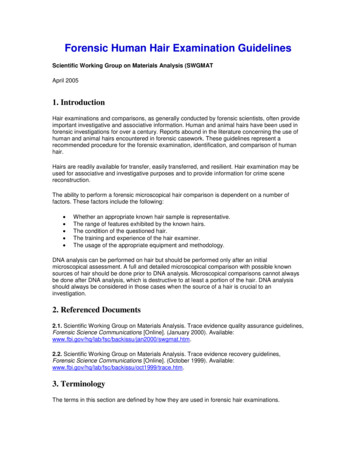
Transcription
Forensic Human Hair Examination GuidelinesScientific Working Group on Materials Analysis (SWGMATApril 20051. IntroductionHair examinations and comparisons, as generally conducted by forensic scientists, often provideimportant investigative and associative information. Human and animal hairs have been used inforensic investigations for over a century. Reports abound in the literature concerning the use ofhuman and animal hairs encountered in forensic casework. These guidelines represent arecommended procedure for the forensic examination, identification, and comparison of humanhair.Hairs are readily available for transfer, easily transferred, and resilient. Hair examination may beused for associative and investigative purposes and to provide information for crime scenereconstruction.The ability to perform a forensic microscopical hair comparison is dependent on a number offactors. These factors include the following:Whether an appropriate known hair sample is representative.The range of features exhibited by the known hairs.The condition of the questioned hair.The training and experience of the hair examiner.The usage of the appropriate equipment and methodology.DNA analysis can be performed on hair but should be performed only after an initialmicroscopical assessment. A full and detailed microscopical comparison with possible knownsources of hair should be done prior to DNA analysis. Microscopical comparisons cannot alwaysbe done after DNA analysis, which is destructive to at least a portion of the hair. DNA analysisshould always be considered in those cases when the source of a hair is crucial to aninvestigation.2. Referenced Documents2.1. Scientific Working Group on Materials Analysis. Trace evidence quality assurance guidelines,Forensic Science Communications [Online]. (January 2000). swgmat.htm.2.2. Scientific Working Group on Materials Analysis. Trace evidence recovery guidelines,Forensic Science Communications [Online]. (October 1999). trace.htm.3. TerminologyThe terms in this section are defined by how they are used in forensic hair examinations.
Amorphous medulla is a medulla that has no distinct form, pattern, or shape when viewed with atransmitted light microscope.Anagen is the active growth phase of a hair follicle in the hair growth cycle. The root from a pulledanagen hair is elongated, may be covered with a root sheath, and is usually fully pigmented.Association is the determination that two or more hairs could share a common origin.Bleaching is a chemical or a natural process used to make a hair colorless or lighter than its usualcolor.Buckling is an abrupt change in the shape and orientation of a hair shaft with or without a slighttwist, often seen in pubic hairs.Catagen is the transitional phase of the hair follicle from the active growth phase (anagen) to theresting growth phase (telogen) in the hair growth cycle.Caucasoid is an anthropological term designating one of the major groups of human beingsoriginating from Europe and originating from the Indian subcontinent.Characteristic is a microscopic or macroscopic feature or attribute of a hair.Color is the aspect of objects that may be described in terms of hue, lightness, and saturation. Itshould be recognized that the macroscopical and microscopical colors of hairs might appeardifferent.Comparison is the examination of two or more hairs to evaluate whether or not they could havecome from the same source.Continuous medulla is a medullary appearance showing no disruptions along the shaft of the hair.Convolution is a rotation or twisting of the hair shaft that can occur naturally, from disease, or as aresult of mechanical force.Cortex is the primary anatomical region of a hair between the cuticle region and the medullaryregion composed of elongated and fusiform cells.Cortical fusi are small spaces that appear as tiny dark structures in the hair shaft; they can befilled with air or liquid.Cortical texture is the relief or definition of the margins of the cortical cells when viewed usingtransmitted light microscopy.Cracked cuticle is a cuticle with linear breaks that are perpendicular to the length of the shaft.Cross-sectional shape is the shape of a hair shaft cut and viewed at a right angle to itslongitudinal axis.Cuticle is the outermost region of a hair composed of layers of overlapping scales.Cuticle thickness is the relative size of the cuticle from its outer margin to the cortex when viewedmicroscopically. This is usually described as thin, medium, or thick.
Deoxyribonucleic acid (DNA) is a long macromolecule that carries a person's genetic information.Discontinuous medulla is a medullary appearance in which the proportion of the visible areas ofmedulla is greater than the areas when the medulla is not visible.Dissimilar is a term that refers to the existence of significant differences among questioned andknown hairs.Distal end is the end of the hair away from the root.Dye is a chemical used to artificially color hair.Eumelanin is the brown pigment occurring in human and animal hair.Follicle is the cavity in the skin from which hair grows.Follicular tag is tissue from a hair follicle that is still attached to the root end of a hair.Fragmented medulla is a medullary appearance in which the proportion of the visible areas ofmedulla is less than the areas when the medulla is not visible.Fungal tunnels are air pockets in a hair shaft caused by fungal growth.Fusiform is a term that refers to a spindle-shaped (tapered at each end) gap present in the hairshaft.Hair is a fibrous outgrowth from the skin of mammals.Hair peripilar cast is a freely movable, firm, yellowish-white material ensheathing scalp hairsresulting from scalp disorders, such as psoriasis or seborrhoeic dermatitis.Identification is the process of classifying a given hair as a member of a defined class of hairs(e.g., human, animal, body area).Imbricate is a term that describes a scale pattern with edges overlapping in a wavy pattern. Thispattern is typical of human hair.Inconclusive is a term that refers to a conclusion that is reached due to the inability to include orexclude a questioned hair as similar to the known hair sample.Individualization is the process of attempting to determine whether a given hair came from oneparticular (person) source to the exclusion of all other sources. This is not possible with forensicmicroscopical hair comparison.Inner cuticle margin is the apparent border between the cortex and the visible cuticle.Keratin is a class of sulfur-containing fibrous proteins that forms the foundation of outgrowthtissue from the epidermis, such as hair, nails, feathers, and horns of animals.Known sample is a collected hair sample intended to be representative of a particular body areaof a specific person or animal.
Lanugo are fine hairs found on newborns, lost shortly after birth.Lice are parasitic insects that may be found on humans. These include head lice, body or clothinglice, and crab lice that live in the pubic region, eyelashes, or eyebrows.Limited sample is a sample of known hairs that is insufficient in quality or quantity to adequatelyrepresent all possible characteristics or traits.Looped cuticle is a feature in which the distal edges of the cuticular scales are curved from or cuptoward the hair shaft.Macroscopic is a term that describes characteristics large enough to be perceived withoutmagnification.Medial region is the portion of the hair between the proximal and distal ends.Medulla is the core of the hair shaft that is composed of air vacuoles and cells.Medullary configuration is the form of medullary cells from the proximal end to the distal end ofthe hair shaft.Melanin is a natural pigment of which two forms, eumelanin and phaeomelanin, determine thecolor of human and animal hair.Microscopic is a term that describes characteristics too small to be resolved by the unaided eyebut large enough to be resolved with the microscope.Mitochondrial DNA (mtDNA) is DNA found in the mitochondria of cells.Mongoloid is an anthropological term designating one of the major groups of human beingsoriginating from Asia, excluding the Indian subcontinent and including Native American Indians.Monilethrix is a hair disorder that results in periodic nodes or beading along the length of the hairwith intervening, tapering constrictions that are not medullated.Negroid is an anthropological term designating one of the major groups of human beingsoriginating from Africa.Nits are lice eggs attached to the hair shaft.Nuclear DNA (nDNA) is DNA found in the nucleus of cells.Opaque medulla is a medulla with large pockets of air causing it to appear black when viewedwith transmitted light microscopy.Ovoid bodies are oval-shaped, heavily pigmented bodies usually found in the hair cortex.Peripheral region is the portion of the hair including the cuticle and the outer areas of the cortexmost distant from the medullary or central region.Phaeomelanin is a reddish-brown to yellow pigment occurring in human and animal hair.
Pigment aggregation is the cluster of individual pigment granules.Pigment density is the relative abundance of pigment granules in the hair cortex when viewedmicroscopically.Pigment distribution is the pattern of the pigment granules observed in the hair shaft, such asuniform, peripheral, one-sided, variable, or central.Pigment granules are small particles in a hair that impart color.Pili annulati is a hair disorder that results in ringed or banded hair, alternating bright and darkbands in the hair shaft. The dark bands are a manifestation of the abnormal air spaces in thecortex.Pili torti is a genetic hair disorder characterized by the hair shaft being flattened and twisted 180degrees numerous times along its axis. It is usually found at irregular intervals along the shaft.Polymerase chain reaction (PCR) is a laboratory process in which specific short segments ofDNA are replicated (amplified) to enable subsequent analysis and identification.Postmortem banding is the appearance of an opaque microscopic band near the root area ofhairs from a decomposing body.Proximal end is the portion of the hair towards the root.Putrid root is a tapered or brush-like appearance of the proximal end caused by decomposition.Questioned sample is a sample of unknown origin.Range is the variation of a specific characteristic exhibited by a hair or hairs from one person.Representative sample is a collection of hairs from a specific body area that reflects the range ofcharacteristics in a person's hair.Root is the follicular structure at the proximal end of a hair.Root sheath is the follicular tissue occasionally found surrounding a root structure.Sample is one or more hairs used for identification, comparison, and/or reference.Scales are tiny plate-like structures composed of keratin that forms the cuticle.Serrated cuticle is a cuticle in which the outer margin has the notched appearance of a saw blade.Shaft is the portion of the hair external to the hair follicle.Shaft form is the macroscopic shape of the hair.Shaft thickness is the diameter of the hair. This may be expressed numerically or in relative terms,such a thin, medium, or thick.
Shouldering is a radial protrusion of the hair shaft causing an irregular cross-section.Similar is a term used to describe an association among questioned and known hairs. This termimplies that no significant unexplained differences exist among the known and questioned hairsor that they are indistinguishable. This term has been used interchangeably with consistent with,cannot be eliminated, could have come from, could have originated from, match, microscopicallyalike, and the same as.Somatic is an area of the body, such as head, pubic, or leg.Splitting is damage usually occurring at the distal end of a hair when the hair divides down thelong axis.Telogen is the last phase of the hair growth cycle when the hair root becomes keratinized andbulbous-shaped (club-like).Texture is the appearance and feel of a hair due to its length, thickness, and shaft form.Tip is the most distal end of a hair shaft.Translucent is a condition when light is transmitted through a material and diffused so that objectsbeyond cannot be seen clearly. The appearance of a medulla that has cells filled with fluid ratherthan air is translucent rather than opaque.Trichology is the study of hair.Trichonodosis is a condition characterized by apparent or actual knotting of the hair.Trichoptilosis is a disease condition characterized by longitudinal splitting or fraying of the hairshaft.Trichorrhexis invaginati is a genetic disease characterized by a segment of bulbous, dilated hairenfolded into a concave hair terminal, recalling the appearance of a bamboo node. If the hairbreaks at the bulbous end, the hair has a golf-tee cup end.Trichorrhexis nodosa is a condition characterized by the formation of nodes. The hair is weaker atthe node and subject to breakage.Trichoschisis is a condition characterized by brittle hair with a transverse crack or a clean break.Undulation is change in the true diameter along the length of the hair shaft that results in changein the cross-sectional shape. This can give the hair a wavy appearance.Vellus are fine body hair.4. Duties, Qualifications, and TrainingThe duties, qualifications, and training of a hair examiner are in the Scientific Working Group onMaterials Analysis Trace Evidence Quality Assurance Guidelines available tm.
5. Summary of GuidelinesThese guidelines include a summary of techniques for collecting hair samples, a description ofthe instrumentation used in the microscopical examination of hair, a description of themicroscopical examination, a discussion on how to interface with subsequent DNA analysis ofhair, and a discussion of the conclusions that result from the microscopical hair examination.6. Significance and UseA hair examination is usually used to determine if the item isA hair.From a human or another animal.From certain body areas.Characteristic of a certain racial group.Characteristic of a particular growth phase.Damaged.Diseased.Associated with other trace evidence.Chemically altered, such as dyed or bleached.Suitable for microscopical comparison.Suitable for DNA analysis.Similar to a known hair sample from a particular person.Most often, hairs from the scalp and pubic regions of the body are used for microscopicalcomparisons. There is usually more interpersonal variability in the characteristics of scalp andpubic hairs than in the hairs from other body regions. Scalp hairs usually show more interpersonalvariation than pubic hairs. Hairs from other body areas may also be compared, but thesecomparisons are usually less significant and less frequently conducted. Accordingly, theseguidelines primarily reflect the considerations of human scalp and pubic hair comparisons.It should be noted that microscopical hair comparisons are not a means of positive identification.7. Sample CollectionRefer to the Scientific Working Group on Materials Analysis Trace Evidence Recovery Guidelines,Section 5, available at www.fbi.gov/hq/lab/fsc/backissu/oct1999/trace.htm for an overview of traceevidence recovery and packaging guidelines. The following is an expansion as applied to hairevidence.7.1. Questioned SampleLoose hairs should be collected from an object by picking them off individually. Hairs that areembedded in or adhering to a person or object must be carefully inspected before removal. Ifappropriate, the location of these hairs should be carefully documented. Care must be taken notto contaminate, crush, or break the hairs.The remaining hairs can be collected from clothing, bedding, or other large surfaces by adhesivelifts. Be aware that the adhesive from the lifting material could interfere with the analysis ofsurface treatments that might be present on the hairs. Hairs can also be collected from an item byscraping or vacuuming. These techniques are described in the Trace Evidence RecoveryGuidelines.
When retrieving evidence from a person's head or pubic region, the combing technique can beused. Always use a new comb or brush. Lacing the teeth of a comb with clean cotton or gauzemay help to retain hairs and debris on the comb. Place a piece of clean paper under the area thatis combed to catch loose hairs and debris. This paper should be included in the evidencepackage with the comb.7.2. Known SampleCollect known hairs from specific somatic regions of relevant people for comparisons toquestioned hairs. Every effort should be made to see that these hairs are collected as soon aspossible relative to the occurrence.Full length hairs with roots should be obtained for the examiner to examine and compare hairs.Because the majority of pulled hairs will likely be in an active growing stage, a separate combingprocedure can be used to obtain hairs in the telogen stage. A combing procedure for known hairscan be done after the combing for foreign hairs. The regions being sampled should be repeatedlycombed or brushed over a large sheet of clean paper. It is desirable to package the pulled knownhairs and combed known hairs separately.Different hairs from the same body region of a person exhibit variation in microscopicalcharacteristics and features. Therefore, it is important to obtain a sufficient number of hairs inorder to adequately represent the range of values of all characteristics present. If the range islarge, it becomes necessary to obtain a large number of hairs. Package hairs from the differentbody areas in separate containers.A known head hair sample should consist of hairs from the five different areas of the scalp (top,front, back including nape, and both sides). Known hair samples should be obtained by acombination of pulling and combing from the sampled region. Ideally, a total of 50 hairs should beobtained from the scalp. A known pubic hair sample or a sample from any other somatic regionshould ideally consist of 25 hairs obtained by pulling and combing from different regions. Acomparison can still be performed with less than the recommended number of hairs, but this mayincrease the likelihood of a false exclusion.Known samples may be requested from all persons who might reasonably be considered asource of a questioned hair. If such samples are obtained and excluded as the source of thequestioned hair, the significance of any ensuing association is increased.8. Summary of Equipment8.1. StereomicroscopeA stereomicroscope with a magnification range up to 100X is useful for the initial examination ofmounted and unmounted hairs.8.2. Transmitted Light MicroscopeA high-quality transmitted light microscope is necessary to examine and identify the microscopicalcharacteristics of hairs. The objectives and eyepieces should permit observations in the range ofapproximately 40X to 400X. A polarized light microscope may enhance the hair examiner's abilityto see certain features and determine the cross-sectional shapes of the hairs.8.3. Comparison Microscope
The use of a high-quality transmitted light comparison microscope is mandatory when comparingthe microscopical characteristics of hairs. High-quality objectives are important, but highlycorrected planapochromats are not necessary. The objectives and eyepieces selected, however,should permit observations in the range of approximately 40X to 400X. A high-intensity tungstenlight source, suitable for photomicrography and equipped with a daylight correction filter, providesadequate lighting. Both sides of a comparison microscope should be balanced for light intensityand color. A comparison microscope may be equipped with one of several types of stages.8.4. Microscope Maintenance and Performance Check8.4.1. MaintenanceThe hair examiner should be familiar with the instruction manual and the manufacturer'smaintenance recommendations for each microscope used in hair examination.To ensure the precision, reliability, and performance of the polarized light and comparisonmicroscopes, the following procedures for the maintenance of the microscopes should beperformed on a routine basis.Clean dust, oil, and dirt from the optics according to the manufacturer's recommendations.Clean the external surfaces.Check the optical alignment and realign, if necessary, to establish proper illumination.When not in use, cover with dust cover.If the microscope cannot be cleaned or aligned properly, discontinue use until themicroscope is repaired.Record all service and repairs in a log; however, routine cleaning and aligning of themicroscope need not be recorded in the log.8.4.2. Performance and calibration checks8.4.2.1. Calibration of the ocular micrometerIn order to measure the thickness of a hair, the examiner must have a calibrated ocularmicrometer in the microscope. The steps for calibrating the ocular micrometer are listed below.Place a stage micrometer with a linear scale of known dimensional divisions on the stageof the microscope.Focus on the dividing lines of the stage micrometer.Align the scale in the ocular with the scale on the micrometer.Determine the number of ocular divisions that equal a defined increment of the stagemicrometer.If 10 ocular units equal 100 microns, then each ocular unit is 10 microns at thismagnification.This procedure should be repeated for each objective.8.4.2.2. Magnification checkThe magnification of the comparison microscope should be checked to ensure that the left andright images are magnified to the same degree. If the magnification is not the same, the examinershould request matching objectives from the manufacturer.8.4.2.3. Color balance
The color balance of the comparison microscope should be checked to ensure uniform colorbetween left and right fields of view. If the color balance is not acceptable, then the examinershould discontinue use and correct the problem. The color balance can be checked by thefollowing procedure:Cut a uniformly colored sample in half and mount it on two separate slides.Place one slide on the left stage and the other slide on the right stage of the comparisonmicroscope.Compare the color of the images.If the color is balanced, the sample images and the background color on both sides shouldappear to be the same.If the color is not balanced, then correct the problem or contact the microscope manufacturer forinstructions on how to properly balance the microscope for color.9. Microscopical ExaminationThe procedure used by the hair examiner should incorporate the general guidelines discussed inthis document. Evidence handling and the correct use of equipment should be consistent withScientific Working Group on Materials Analysis guidelines.Blood or debris on a hair sample may be significant. If the adhering material is of evidential value,the examiner should consider removing and preserving it for possible future analysis. In asituation when the adhering material is not of evidential value, the hair may be washed or cleanedprior to mounting. The presence of a small amount of blood or debris on a hair may not interferewith the microscopical examination. A washed hair should be allowed to air dry prior to mounting.Hair exhibiting thermal or mechanical damage may be more brittle and should be handledminimally and with more care.9.1. Macroscopical and Stereomicroscopical ExaminationMacroscopical and stereomicroscopical examinations are useful for observing hair characteristics,such as color, length, shape, and texture. This is an important step in identifying hairs, assessingwhich are suitable for comparison, determining the presence of other trace materials, andevaluating which hairs have roots suitable for nuclear DNA analysis.9.2. Transmitted Light MicroscopyThe internal microscopic characteristics of hair can be observed easily in transmitted light whenthe hairs are appropriately mounted.9.2.1. MountingA colorless, nonyellowing mounting medium with a refractive index in the range of 1.50 to 1.60should be used to view hairs in transmitted light. The analysis of surface particulates andbiological material, compatibility with DNA analysis, and ease of artifact isolation can influencethe selection of a mounting medium.One hair or multiple hairs from the same source may be mounted on a glass microscope slidewith an appropriate cover slip. Each mounted hair must be clearly visible. Each slide must be
labeled as to the source of the hairs. Questioned and known hairs should be mounted in thesame type of mounting medium.9.2.2. Questioned hairsQuestioned hairs are examined microscopically to determine if they originate from a human oranother animal. If the hair is of human origin, determine, if possible, race, body area, andsuitability for comparison (See Sections 6 and 10).9.2.3. Known sampleAn adequate number of hairs that represent the range of features present in the sample areselected for comparison. The selection should be primarily based on macroscopical andstereomicroscopical characteristics, such as length, shape, and color. These hairs are mountedand then examined in the same manner as the questioned sample.9.3. Comparison MicroscopyHair comparisons are usually conducted among questioned and known hairs. Comparisons mustbe conducted among hairs of the same somatic region. When possible, the hair examiner shoulduse known hairs of similar length, each with a root present and in a similar growth phase as thequestioned hair. A comparison using the unaided eye or a stereomicroscope may be sufficient forelimination purposes in some cases when the differences are obvious.A hair characteristic at any one area along the length of a questioned hair should be comparedwith that characteristic at the corresponding area along the known or comparison hairs. Theappearance of a particular hair characteristic is usually not constant along successive portions ofa single hair from root to tip. These variations depend on genetic factors and external factors,such as growth phase, hair length, health, environment, and grooming habits. The hair examineridentifies the range of characteristics exhibited by the known sample and compares thesecharacteristics on a side by side basis with the questioned hair(s) using a comparison microscope.It is desirable to have a second hair examiner verify every microscopical hair association that mayhave probative value. The laboratory should have a procedure in place for resolving differencesof opinion that occur during a verification of a hair association.10. Hair Characteristics and Other Determinations10.1. Human or Other Animal OriginHuman hair can be distinguished from other animal hair by examining features, such as scalepattern, medulla, root, color, hair length, and shaft configurations.10.2. Somatic OriginSomatic origin types may include scalp, pubic, facial, limb and body, and eyebrow and eyelashhairs. Somatic origin of human hair can usually be established by considering features, such aslength, cross-sectional shape, shaft configuration, medullary configuration, texture, taper, andappearance of the root.10.3. Racial Group
Features, such as color, shaft configuration, cross-sectional shape, pigment distribution, hairdiameter, and cuticle can be used to classify a hair as having characteristics typical of particularracial groups, such as Caucasoid, Negroid, and Mongoloid. The examiner should be alert to thepossibility of mixed racial characteristics and atypical features. Opinions about the racial origin ofa hair should be formulated with caution.10.4. Human Hair CharacteristicsThe following is a list of characteristics that may be used for classification and comparison ofhairs. The characteristics listed below are not all-inclusive.10.4.1. Macroscopic10.4.1.1. Color (in reflected light)WhiteBlondeRedBrownBlack10.4.1.2. StructureShaft formStraightArcedWavyCurlyTwistedTightly coiledCrimpedShaft length range in centimeters or inchesOverall shaft thicknessFineMediumCoarse10.4.2. Microscopic10.4.2.1. Color (in transmitted light)ColorColorless (white)BlondeRedBrown
BlackNatural pigmentationPigment sizeo Coarseo Mediumo FinePigment aggregationo Streakedo Clumpedo PatchyPigment aggregate sizeo Largeo Mediumo SmallPigment densityo Absento Lighto Mediumo Heavyo OpaquePigment distributiono Uniformo Peripheralo One-sidedo Random or variableo Central or medialo Pigment in cuticleo BandedColor treatmentsDyes (permanent, semipermanent)Temporary dyes (rinses, sprays, gels, mousses)Bleaches or lighteners10.4.2.2. StructureShaft characteristicsDiameter range in μmCross-sectional shapeo Roundo Ovalo Triangularo FlattenedShaft configurationso Bucklingo Convolutingo Shoulderingo Undulatingo Splittingo Regular
ueTranslucentRelative widthAmorphousOther (i.e., doubled, tripled)CuticleCuticleo Presento AbsentCuticle thicknesso Thino Mediumo ThickOuter cuticle margino Flattenedo Smootho Serratedo Crackedo Loopedo Irregular or otherInner cuticle margino Distincto IndistinctCuticle color and clarityo Naturalo Pigmento DyeCortexCellular textureo Coarseo Mediumo FineOvoid bodieso Sizeo Distributiono AbundanceCortical fusio Sizeo Shapeo Distributiono AbundanceEnds
Proximal endso Root present Telogen Catagen Anagen Sheathed Follicular tag Postmortem banding Putrido Root absent Severed Decomposed CrushedDistal endso Tapered tips (uncut)o Rounded or abradedo Square cuto Angular cuto Frayedo Splito Crushedo Brokeno Singed10.4.2.3. Acquired characteristicsArtifactsNits or liceMoldFungal tunnelsInsect bite marksDebrisBloodAbnormalitiesPili annulatiTrichoschisisMonilethrixTrichorrhexis nodosaTrichorrhexis invaginatiPili tortiTrichonodosisTrichoptilosisArtificial treatments (other than color)Hair sprayHair gelPermanentsHair cosmetics
DamageEnvironmental/chemical damageMechanical damageCrushedBurnedGlass cutBrokenFrayedTwi
Pigment aggregation is the cluster of individual pigment granules. Pigment density is the relative abundance of pigment granules in the hair cortex when viewed microscopically. Pigment distribution is the pattern of the pigment granules observed in the hair shaft, such as uniform, peripheral, one-sided, variable, or central. Pigment granules are small particles in a hair that impart color.
